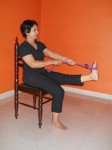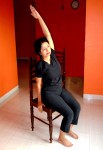Yogic Diet
The ancient texts, Hatha Yoga Pradipika and Bhagavat Gita have emphasized the need of proper diet for the physical, mental and spiritual development of an individual. Yoga Philosophy creates an awareness and educates on eating Sattvic food (pure with prana) and developing healthy habits that promote well being and spiritual growth. The yogis described food as ‘divine’ and ‘a great source of energy.’ They regarded food as ‘Annam Parabrahma Svarupam,’ meaning food is Brahman or God.
You are what you eat Yogis insist on a vegetarian diet. A non-vegetarian diet is consuming animal flesh – it creates dull and heavy feeling and is difficult to digest. Animal flesh cause destruction to the natural rhythm and weaken the systems. They cause impurities and toxins in the body and mind that develop negative emotions like anger, hatred, lust, fear and many health issues.
Yogic diet is a vegetarian and a balanced diet that fulfils all the nutritional needs in order to maintain the mind-body balance. Eating the right food, in the right quantity, with the right attitude, at the right time, is a perfect yogic diet. Yogic diet supports asana and pranayama practice.
Yoga science has classified diet into Sattvic, Rajasic and Tamasic based on the gunas or attributes with which we are born. The three gunas are Sattva (calmness), Rajas (restlessness), Tamas (dullness).
Sattvic diet is freshly cooked vegetarian food consisting of natural, organic foods, free from pesticides. They are foods that grow in harmony with nature and cooked with right attitude with love. They are light and easy to digest, provide positive energies, balance the five elements and promote good health. Yoga practitioners and seekers of wisdom follow this diet.
Sattvic foods are balanced combination of whole grains, legumes, pulses, fresh fruits and vegetables, except onions, garlic and mushrooms. They include dry fruits, milk and milk products, natural sugars like jaggery and honey. Spices include coriander, cumin, fennel, fenugreek, black pepper, sesame, carom seeds, pomegranate seeds, ginger, basil, mint, cardamom, cinnamon and turmeric. Oils include sesame, sunflower, olive and coconut. Bhagavad Gita (17:8) describes Sattvic foods as “promoting life, virtue, strength, health, happiness and satisfaction.”
Rajasic diet consists of food that are over stimulating and destroy the mind-body balance. These foods cause restlessness to the mind, arouse negative emotions and lead to circulatory and nervous disorders. Sattvic foods when eaten in a hurry or with a wrong attitude become Rajasic.
Rajasic foods are stimulants such as coffee, tea, colas, chocolates, tobacco, onion and garlic. They include spicy, sour, fried, fatty and refined foods. Bhagavat Gita (17:9) describes Rajasic foods as “excessively hot, spicy, bitter, salty, pungent, burning the tongue.”
Tamasic diet causes heaviness, dullness and lethargy. They destroy the body’s ability to withstand stress, lower the body’s resistance to disease. They do not have ‘prana’ or the energy required for mind-body balance. Sattvic food when over-eaten or reheated several times becomes Tamasic. Honey when cooked becomes tamasic. Overripe fruits are tamasic.
Tamasic foods are non vegetarian foods, old, stale, burnt and overcooked food. They include meat, fish, chicken, eggs, mushrooms, onion and garlic, vinegar, cigarettes and alcohol. Bhagavat Gita (17:10) describes Tamasic foods as “stale, rotten, tasteless, impure, unripe and overcooked.”



















